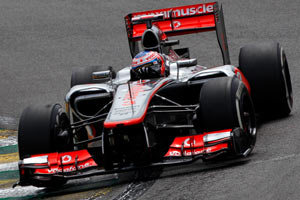shelly wrote:beelsebob wrote:shelly wrote:brian, I think that we are not sharing the same basic ideas. If I find a good article on coanda effect with reference to round jets, I will post the link and we will start from that.
I have some doubts to iron ou about coand for myself; for example I remember reading somewhere that the classic example of the spoon being attracted to the tap water is wrong.
In the mentime, let me draw your attention to one thing: why do both mclaren and ferrari sport a convex ramp after the mandated circular exit of the exhaust pipe?
On the f2002 of 10 years ago that ramp was straight...
On the F2002 though they were trying to aim the gasses just above the suspension arms; on the current McLaren and Ferrari they're trying to aim it at the floor.
That exactly what I was pointing at, for which Pup has given a nice demo.
If there is a convex suface there, then there is the aim to make the plume follow that curve.
Great pictures Pup!
Indeed. It will result in the expansion plume being displaced in the direction of the curvature of the surface it is expanding over. This is not a bell housing for a rocket motor.
We also need to remember that an F1 engine runs rich and that the exhaust gas contains a fair percentage of unburnt HC emissions. Those particles have mass, charge and will therefore behave in a manner where their resultant displacement is a factor of velocity mass, thermodynamic considerations and molecular interaction.
Yes the plume is expanding.
Yes the inner portion of the plume is contracting
Yes the plume if flowing closely enough to a surface will follow the shape of that surface to a degree.
you're all right. The ide is to place the hot air in the appropriate space so that by the time it is cooling and contracting violently it can draw in additional air into a space where that can be used to aid with generating downforce.

